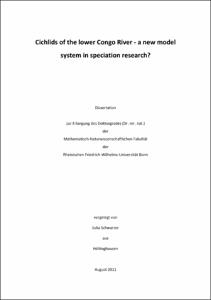Cichlids of the lower Congo River - a new model system in speciation research?

Cichlids of the lower Congo River - a new model system in speciation research?

| dc.contributor.advisor | Misof, Bernhard | |
| dc.contributor.author | Schwarzer, Julia | |
| dc.date.accessioned | 2020-04-17T21:14:05Z | |
| dc.date.available | 2020-04-17T21:14:05Z | |
| dc.date.issued | 07.05.2012 | |
| dc.identifier.uri | https://hdl.handle.net/20.500.11811/5295 | |
| dc.description.abstract | Fishes account for the highest diversity of all vertebrate groups on our planet. Among them one group clearly outnumbers all the others - cichlids (Perciformes, Cichlidae). The present study focuses on cichlids of the lower Congo River, one of the most spectacular habitats for animal life on earth. One primary aim was to establish the lower Congo cichlids as the first model system in speciation research based on riverine species and to emphasize their contribution to general cichlid species diversity. The reconstruction of robust phylogenetic trees and reliable placement of the lower Congo cichlids within a framework of African cichlids were the first goals of the present thesis. The lower Congo cichlid genera are assigned to different cichlid tribes: “Haplochromis”, Lamprologus and Steatocranus belong to the haplotilapiines, a tribe comprising the megadiverse lacustrine radiations and tilapiine genera, and Nanochromis and Teleogramma to the chromidotilapiines, an ancient West/Central African mainly riverine cichlid lineage. Multi-locus phylogenetic trees of both haplotilapiines and chromidotilapiines and more detailed of haplochromines were reconstructed, allowing the identification of biogeographic coherences and general relationships of the lower Congo genera with the remaining African cichlids. Age estimates allowed setting phylogenetic splitting events in context with the palaeohistory of the African continent. Species differentiation along the lower Congo River and potential timing of initial colonization of the lower Congo rapids were inferred by including nearly all to date known species of the genera Steatocranus and Nanochromis. Intrageneric relationships were reconstructed based on extensive multi-locus AFLP datasets in combination with mitochondrial and nuclear sequence data. I could show, that Steatocranus and Nanochromis species predominantly differentiated allopatrically within the lower Congo River in about 5mya. The rapids were colonized in each genus at least twice from surrounding lakes (Nanochromis) and rivers. The existence of various levels of gene flow between adjacent and more distantly related species especially in Steatocranus species and within the haplochromines underlines the non-destructive and potentially even beneficial role of hybridization in cichlids. A rather web-like evolution in the genus Steatocranus doubts the general applicability of bifurcating trees especially in species known to hybridize. | en |
| dc.language.iso | eng | |
| dc.rights | In Copyright | |
| dc.rights.uri | http://rightsstatements.org/vocab/InC/1.0/ | |
| dc.subject | Buntbarsche | |
| dc.subject | Hybridisierung | |
| dc.subject | Molekulare Phylogenie | |
| dc.subject | Kongo-Fluss | |
| dc.subject | Allopatrische Artbildung | |
| dc.subject | Stromschnellen | |
| dc.subject.ddc | 570 Biowissenschaften, Biologie | |
| dc.title | Cichlids of the lower Congo River - a new model system in speciation research? | |
| dc.type | Dissertation oder Habilitation | |
| dc.publisher.name | Universitäts- und Landesbibliothek Bonn | |
| dc.publisher.location | Bonn | |
| dc.rights.accessRights | openAccess | |
| dc.identifier.urn | https://nbn-resolving.org/urn:nbn:de:hbz:5n-28147 | |
| ulbbn.pubtype | Erstveröffentlichung | |
| ulbbnediss.affiliation.name | Rheinische Friedrich-Wilhelms-Universität Bonn | |
| ulbbnediss.affiliation.location | Bonn | |
| ulbbnediss.thesis.level | Dissertation | |
| ulbbnediss.dissID | 2814 | |
| ulbbnediss.date.accepted | 18.01.2012 | |
| ulbbnediss.fakultaet | Mathematisch-Naturwissenschaftliche Fakultät | |
| dc.contributor.coReferee | Bakker, Theo C. M. |
Files in this item
This item appears in the following Collection(s)
-
E-Dissertationen (4335)




